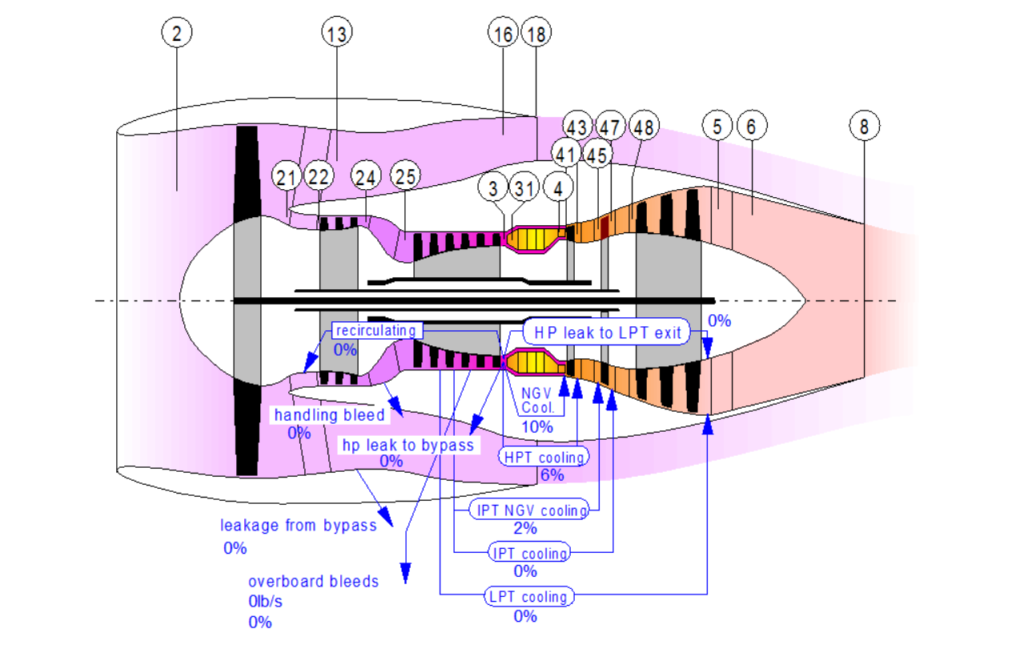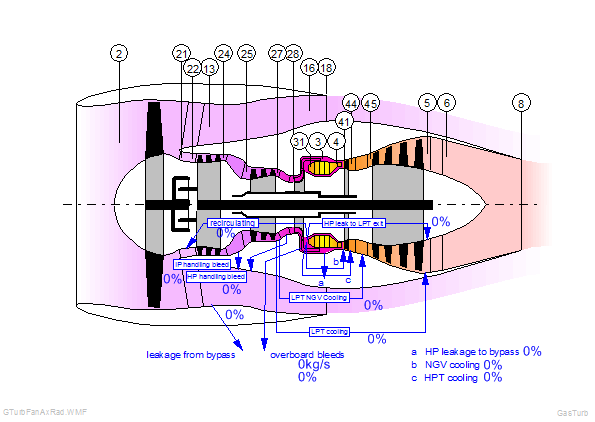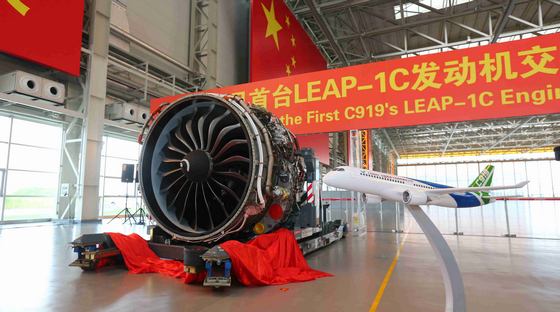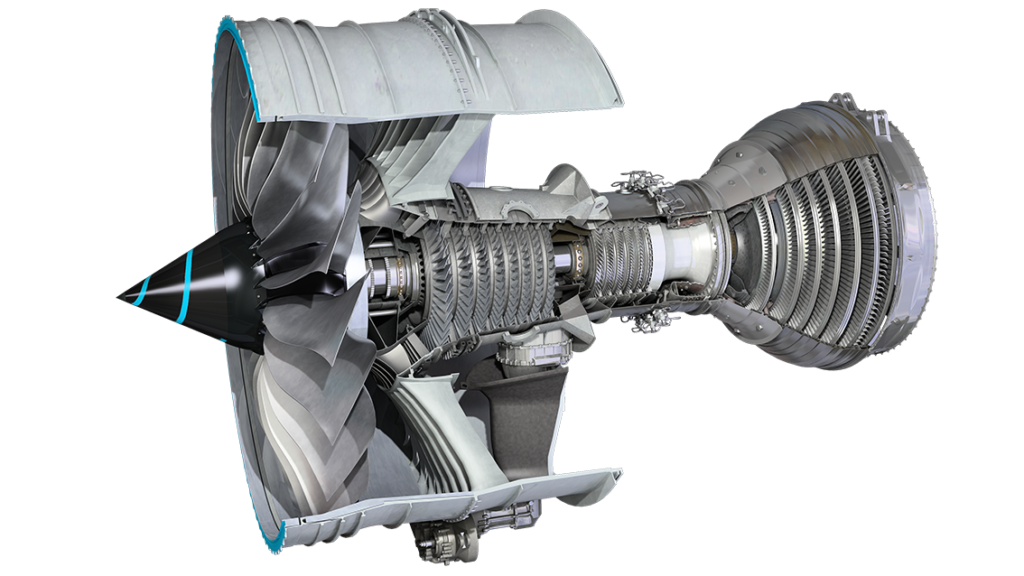Leeham News and Analysis
There's more to real news than a news release.
 Leeham News and Analysis
Leeham News and Analysis
- The Boeing 767 Cross Section, Part 1 November 24, 2022
- Movie Review: Devotion November 21, 2022
- China will accelerate development of its commercial aerospace sector November 21, 2022
- Bjorn’s Corner: Sustainable Air Transport. Part 46. eVTOL comparison with helicopter November 18, 2022
- The economics of a 787-9 and A330-900 at eight or nine abreast November 16, 2022
Bjorn’s Corner: Turbofan developments in 2017
January 06, 2017, ©. Leeham Co: Before we finish of our series on airliner turbofan technology, let’s spend this Corner on what will happen on the airliner engine front during 2017.
While there is no totally new engine that comes into the market during 2017 there are a number of new variants of existing engine families that will be introduced.

Figure 1. GasTurb principal representation of a three shaft turbofan like our reference Rolls-Royce Trent XWB. Source: GasTurb.
If we start with the engines for regional/single aisle aircraft and then climb the thrust scale, we will cover the engines in climbing thrust class.
Posted on January 6, 2017 by Bjorn Fehrm
Bjorn’s Corner; Turbofan engine challenges, Part 7
December 16, 2016, ©. Leeham Co: After the turbine comes the engine’s exhaust system. This is where the thrust characteristics of the engine are formed. It is also the environment that defines the back pressure for the fan and turbines. It’s therefore more high-tech than one thinks.
For the very high bypass airliner engines of tomorrow, the common fixed bypass exhaust of today (Station 18 in Figure 1) will not be acceptable. Variable exhaust areas will have to be introduced.

Figure 1. GasTurb principal representation of a three shaft turbofan like our reference Rolls-Royce Trent XWB. Source: GasTurb.
On engines that function in high supersonic speed, it gets really complex. Not only is the exhaust area variable, it must have a dual variation exhaust, a so-called Con-Di nozzle.
Posted on December 16, 2016 by Bjorn Fehrm
Bjorn’s Corner; Turbofan engine challenges; Part 6
December 08, 2016, ©. Leeham Co: We have now come to the turbine in our trip through a modern turbofan. The turbines make up the rear of the engine, before the propelling nozzle.
The turbines are the workhorses in the engine. They take the energy released by the fuel in the combustion chamber and convert it to shaft hp to drive the fan or compressors.

Figure 1. GasTurb principal representation of a three-shaft turbofan like our reference Rolls-Royce Trent XWB. Source: GasTurb.
The hotter they can operate, the better. They can then generate more hp on a smaller size turbine. The temperature of the gas entering the high pressure compressor is one of the key parameters of a gas turbine. It dictates the power efficiency of the core and how much work it can perform to drive the fan and the compressors. Read more
Posted on December 9, 2016 by Bjorn Fehrm
Bjorn’s Corner: Turbofan engine challenges, Part 5
By Bjorn Fehrm
December 02, 2016, ©. Leeham Co: We will now look at the combustor area in our series on modern turbofan engines. There is a lot of activity in this area, as it sets the level of pollution for the air transportation industry for some important combustion products.
We will also finish off the compressor part of our series by looking at the bleeding of cooling air for the engine and for servicing the aircraft with air conditioning and deicing air.

Figure 1. GasTurb principal representation of a three-shaft turbofan like our reference Rolls-Royce Trent XWB. Source: GasTurb.
The amount of air which is tapped from compressor stages for cooling and other purposes can exceed 20% of the core flow (some of the flow paths are shown in Figure 1). At that level, it has a marked influence on the performance of the engine. Read more
Posted on December 2, 2016 by Bjorn Fehrm
Bjorn’s Corner: Turbofan engine challenges, Part 4
November 18, 2016, ©. Leeham Co: In our series on modern turbofan airliner engines, we will now go deeper into the compressor part. Last week, we covered the fundamentals of compressors. As compressors and turbines use the same principles, we also covered the fundamental working principles of turbines.
We also described that compressors are temperamental parts, which can protest to wrong handling with violent “burps” (burst stalls with the combustion gases going out the front of the engine) or end up in a rotating stall where it simply stops working.

Figure 1. Stylistic cross section of a two shaft turbofan with both axial and radial compressor. Source: GasTurb.
Turbines, on the other hand, are your robust companions. Aerodynamically they just work, albeit more or less efficiently dependent on what one asks them to do (mechanically it can be very different; we recently saw a turbine disintegrate with large consequences on an American Airlines Boeing 767 in Chicago). More on the turbines later.
In the GasTurb cross section of a two shaft turbofan in Figure 1, the engine has both an axial and a radial compressor. We will consider why engine designers combine these two for certain engine types. Read more
Posted on November 18, 2016 by Bjorn Fehrm
Bjorn’s Corner: Turbofan engine challenges, Part 3
November 12, 2016, ©. Leeham Co: In our trip through a modern turbofan airliner engine and its technologies, we looked last week at the engine intake and the fan. We now continue with the compressor parts.
As compressors and turbines use the same principles (but in opposing ways), we will look at these principles this week and how their roles in the engine create their special characteristics.
As before, to make things concrete, we use a GasTurb simulation of a Rolls-Royce Trent XWB 84k engine to look at practical data when needed. As before, I have no specific knowledge about the engine and will not use any data outside what is public information.
The GasTurb cross section of a three-shaft turbofan is shown in Figure 1. We will examine the sections between station numbers (22) and (3) and (4) and (5) in the general discussion of compressors and turbines. We will then look at some data for common compressors. Read more
Posted on November 11, 2016 by Bjorn Fehrm
Bjorn’s corner; Turbofan engine challenges; Part 2
November 04, 2016, ©. Leeham Co: We will now start to go through a modern turbofan airliner engine and look at the technologies which are used and what are their technical challenges. We will start today with the engine intake and the fan.
To make things concrete, we will use a GasTurb simulation of a Rolls-Royce Trent XWB 84k engine. This will provide us with realistic example data for the different parts of the engine. I want to stress that all values are assumed as typical for such an engine. I have no specific knowledge of the Trent XWB and will not use any data outside what is public information.
The GasTurb cross section of a three-shaft turbofan is shown in Figure 1. We will use the station numbers in the figure to navigate the engine and the data from the simulation to understand modern airline engines and their typical data. Read more
Posted on November 4, 2016 by Bjorn Fehrm
Bjorn’s Corner: The Engine challenge
October 21, 2016, ©. Leeham Co: In our Corners on East bloc aeronautical industries, we could see that the hardest part to master in a new civilian airliner is the engine.
Both new airliners from Russia and China (Irkut MC-21 and COMAC C919) start their lives with Western engines.
Why is this so? What are the challenges that make engines harder to create than aircraft?
We will spend several Corners on the main reasons that airliner engines are harder to do than aircraft. Read more
Posted on October 21, 2016 by Bjorn Fehrm
Engine industry clamoring for road back
By Bjorn Fehrm
Subscription required.
Introduction
October 13, 2016, ©. Leeham Co: The airline engine industry is like a ticking bomb. Over the years, a business practice of selling the engines under manufacturing cost and planning to recover costs and make a profit on the aftermarket developed. This goes back decades.
The practice was fostered by fierce competition over the engine contracts for aircraft which offered alternative engines. The losses of the engine sales could be made up later by selling spare parts and services at high margins.
These “jam tomorrow” practices have several implications. The engine industry is now confronted with these and wonder how it could put itself in such a bind. How to handle these and what is the way back?
Summary:
- High competition in engine sales forced ultra high discounts for the up-front engine sale.
- Aftermarket schemes was created that should recover profits over spare parts and services.
- But these maintenance practices create all sorts of problems in the used engine market.
- The engine industry now wants to return to more normal business practices. But how do they find the way back?
Posted on October 13, 2016 by Bjorn Fehrm
Email Subscription
Twitter Updates
My TweetsAssociations
Aviation News-Commercial
Commentaries
Companies-Defense
Resources
YouTube
Archives
- November 2022
- October 2022
- September 2022
- August 2022
- July 2022
- June 2022
- May 2022
- April 2022
- March 2022
- February 2022
- January 2022
- December 2021
- November 2021
- October 2021
- September 2021
- August 2021
- July 2021
- June 2021
- May 2021
- April 2021
- March 2021
- February 2021
- January 2021
- December 2020
- November 2020
- October 2020
- September 2020
- August 2020
- July 2020
- June 2020
- May 2020
- April 2020
- March 2020
- February 2020
- January 2020
- December 2019
- November 2019
- October 2019
- September 2019
- August 2019
- July 2019
- June 2019
- May 2019
- April 2019
- March 2019
- February 2019
- January 2019
- December 2018
- November 2018
- October 2018
- September 2018
- August 2018
- July 2018
- June 2018
- May 2018
- April 2018
- March 2018
- February 2018
- January 2018
- December 2017
- November 2017
- October 2017
- September 2017
- August 2017
- July 2017
- June 2017
- May 2017
- April 2017
- March 2017
- February 2017
- January 2017
- December 2016
- November 2016
- October 2016
- September 2016
- August 2016
- July 2016
- June 2016
- May 2016
- April 2016
- March 2016
- February 2016
- January 2016
- December 2015
- November 2015
- October 2015
- September 2015
- August 2015
- July 2015
- June 2015
- May 2015
- April 2015
- March 2015
- February 2015
- January 2015
- December 2014
- November 2014
- October 2014
- September 2014
- August 2014
- July 2014
- June 2014
- May 2014
- April 2014
- March 2014
- February 2014
- January 2014
- December 2013
- November 2013
- October 2013
- September 2013
- August 2013
- July 2013
- June 2013
- May 2013
- April 2013
- March 2013
- February 2013
- January 2013
- December 2012
- November 2012
- October 2012
- September 2012
- August 2012
- July 2012
- June 2012
- May 2012
- April 2012
- March 2012
- February 2012
- January 2012
- December 2011
- November 2011
- October 2011
- September 2011
- August 2011
- July 2011
- June 2011
- May 2011
- April 2011
- March 2011
- February 2011
- January 2011
- December 2010
- November 2010
- October 2010
- September 2010
- August 2010
- July 2010
- June 2010
- May 2010
- April 2010
- March 2010
- February 2010
- January 2010
- December 2009
- November 2009
- October 2009
- September 2009
- August 2009
- July 2009
- June 2009
- May 2009
- April 2009
- March 2009
- February 2009
- January 2009
- December 2008
- November 2008
- October 2008
- September 2008
- August 2008
- July 2008
- June 2008
- May 2008
- April 2008
- March 2008
- February 2008





2017: the year ahead
Subscription Required
Introduction
Jan. 3, 2017, © Leeham Co.: The New Year is here and it doesn’t look like a good one for commercial aerospace, if measured against previous outstanding years.
There are some troubling signs ahead, piling on to a slowdown in orders from last year that didn’t even reach a 1:1 book:bill.
This year looks to be worse than last. Airbus and Boeing will give their 2017 guidance on the earnings calls this month and next. Bombardier and Embraer earnings calls are a ways off, when each will provide its guidance.
But LNC believes the Big Two in particular will be hard pressed to hit a 1:1 book:bill this year and may even struggle to match 2016 sales.
Boeing’s year-end order tally comes Thursday. Airbus’ comes on Jan. 11.
Summary
Read more
1 Comment
Posted on January 3, 2017 by Scott Hamilton
Airbus, ATR, Boeing, Bombardier, CFM, Comac, CSeries, E-Jet, Embraer, Etihad Airways, Farnborough Air Show, GE Aviation, Irkut, Leeham News and Comment, Middle of the Market, Mitsubishi, Pratt & Whitney, Premium, Rolls-Royce, Sukhoi
Airbus, Boeing, Bombardier, CFM, Comac, Embraer, GE Aviation, Irkut, Mitsubishi, Pratt & Whitney, Rolls-Royce, Sukhoi